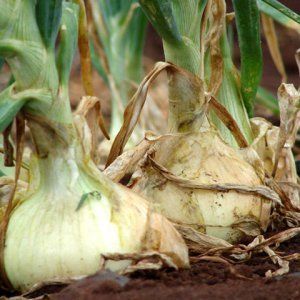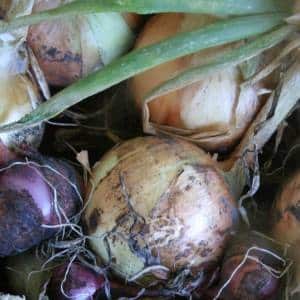Harvesting and storing onions: when is it time to dig them out of the garden?
The safety of the harvest largely depends on the timeliness and quality of harvesting. How to properly collect onions from the beds so that they can be stored for a long time? Read the article about the rules for harvesting onions, harvesting times and storage features.
When to remove onions from the garden for storage
The signal for harvesting is the cessation of plant nutrition. Signs of bulb ripening:
- yellow withered tops;
- the head of the vegetable is hard, dense, covered with dry husk;
- the stem at the base is flattened and withered;
- When the neck of the onion is cut, no juice comes out when pressed.
When to stop watering
Onions are collected dry, so they will not rot and will last all winter. In order for the vegetable to reach the desired condition, watering is stopped at the first signs of wilting and drying of the tops, at least two weeks before the expected harvest date.
How to speed up maturation
Sometimes, due to cool weather, the ripening of vegetables is delayed. In order to have time to harvest before the autumn rains and possible frosts, experienced gardeners advise:
- Rake the soil away from the heads to about half; within a week they will dry out and become ready for harvesting;
- Use a pitchfork to carefully lift the soil to a depth of about 5 cm under the bulbs; the roots will come off and the plants will stop feeding.
Important! You cannot cut leaves to speed up ripening, even if they have begun to turn yellow. Pruning at the root impairs keeping quality; fresh cuts can become infected and the heads can rot.
Timing for harvesting onions from the garden
The growing season and ripening period depends on the variety, growing region, weather conditions and averages 2-2.5 months.
Approximate cleaning dates depending on region
|
Region |
Landing time |
Collection time |
| Middle lane | Until mid-May | Second half of July |
| Siberia | Last ten days of May | End of July - beginning of August |
| Ural | Second ten days of May | End of July |
When to harvest onions is determined by the condition of the plants. If the summer is dry and hot, ripening occurs 7-10 days earlier.
What is the danger of untimely harvesting?
Untimely cleaning leads to deterioration in shelf life and quality. If you hurry and dig up damp bulbs, they will rot during storage.
Ready-to-harvest plants, left in the ground, after 10-14 days again release roots and begin to grow. The bulb spends stored nutrients, and the taste and preservation of the vegetable deteriorate.
How to dig properly

When deciding when to dig up onions, consider the weather. Choose a sunny, warm day. It is better to start harvesting in the morning; during the day the bulbs will air out in the garden bed and will be ready for further processing.
The lunar calendar is another assistant to the summer resident in setting the date of harvesting work. The days of the waning moon and the new moon are considered favorable. However, use common sense in everything. If the forecast promises prolonged rains, you should not wait for the new moon; harvest onions on fine days.
Cleaning
The bulb is carefully dug up with a pitchfork and removed from the soil, pulling the tops so as not to damage the bottom. Adhering clods of earth are removed by hand, in no case by tapping the heads against each other. Otherwise, the onions will become wrinkled and spoil during storage.
On a note. You can pull out onions by the leaves if the garden has sandy or loose peaty soil.
The dug vegetable, without cutting, is laid out in one layer on the bed for pre-drying. The crop is then moved under a shed or into a ventilated shed to dry.
Drying
Drying under a canopy lasts 1.5-2 weeks. If the weather permits, take the onions out into the sun for the day, and put them under the roof at night so that the vegetable does not get wet from dew.
During this time, the tops and roots will dry out completely. The heads will be covered with an additional layer of dense scales. There is no need to peel them: the more husk on the bulbs, the better they will be preserved.
How to trim onions after harvesting from the garden
The collected and dried vegetables are trimmed before storing:
- the tops are cut off, leaving a tail 5-8 cm long;
- the roots are shortened to 0.5-1 cm.
On a note. If you plan to store the vegetable in bunches, do not cut off the tops.
During the pruning process, the bulbs are immediately sorted. Damaged, dented, or rotten heads are not suitable for storage.
Storing onions
Under the right conditions, the vegetable will remain fresh and healthy until spring.
Storage conditions
Onions are stored in dry, ventilated rooms, in a dark place with a temperature of 18-20°C. If possible, it is better to place the vegetable in a cool, dark pantry with a temperature of 5-10°C.
On a note. Inspect the bulbs regularly and remove spoiled ones to avoid contaminating the entire crop.
Methods

There are many ideas on how to store onions in an apartment.
Boxes
Place the bulbs in small wooden or plastic boxes. Air circulates freely through the holes in the walls: the bottom and onions remain dry and strong. There are special boxes for storing vegetables on sale.They can be easily stacked on top of each other, which will significantly save space.
Carton boxes
In every home there is unnecessary cardboard containers (shoe boxes, small household appliances, etc.). It’s convenient to store onions in it; you just need to make holes in the walls for ventilation.
Baskets made of wicker
The wicker basket allows air to pass through and the bulbs in it practically do not rot. Choose small ones, up to 5 liters in volume.
Fabric bags
The main thing is that the bags should be made of natural material: burlap, linen, cotton. Pour 4-5 kg of onions into a bag and place it on shelves or under the bed.
Nylon tights
This time-tested method ensures neat and secure storage. If you tie a knot over each onion after planting, it will end up in a kind of individual pocket and will last longer.
Storage in mating
Economical and aesthetic way. Make a braid using uncut onion leaves and strong twine:
- Choose bulbs that are approximately the same size, take one with the longest and strongest feathers.
- Tie a rope to the base of the foliage of the first head so that you have three ends: two from ropes, one from onion tops.
- Weave a simple braid, adding one bow on each side the next time you grab it.
- Leave about 10cm of rope on each side and make a strong loop.
The braids are stored hanging in a cool, dry place.
Harvesting and storing other types of onions
The collection and storage of each type of onion has its own characteristics.
Sevok

Sevok is the “youth” stage of onions. It takes 90-100 days from sowing the seeds to ripening. The collection of seedlings usually occurs at the end of August.
The bulbs are small, so harvesting requires delicacy.They dig up the soil with a pitchfork, carefully remove the onion sets from the garden bed and clear the soil. Dry for at least two weeks under a canopy and trim. Store at temperatures up to 20°WITH in a dry, dark place.
shallot
It has a sweet taste and tender onion. It ripens earlier than onions, and must be harvested before the end of July. Well dried Shallots can be stored for up to six months in boxes, baskets or bundles.
Leek
This type of onion is cold-resistant and feels great in open ground until the end of September. Leeks are harvested for storage before frost. Undamaged plants with a strong bottom are selected, the tops are shortened to 25 cm.
You can store leeks until mid-winter in the cellar - in a box with wet sand. A layer of sand is poured onto the bottom of the container. Plants are placed upright and sprinkled with sand so that only leaves remain on the surface.
Read also:
How to eat onions for weight loss: recipes for dietary dishes.
Conclusion
The condition of the plants will tell you when to harvest onions. The tops turn yellow and wither, sap flow stops, and the bulbs become covered with dense husks. Harvest time depends by variety, weather conditions, growing region. As a rule, harvesting time occurs at the end of July - the first half of August. Before storing, the bulbs are dried, trimmed and sorted. Onions can be stored for up to six months in cool, dry places.